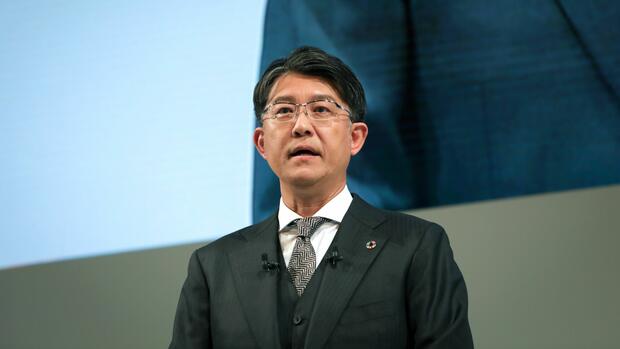Tokyo The new Toyota boss Koji Sato sets himself an ambitious goal right from the start. The world’s largest car manufacturer now wants to sell eleven million vehicles in the current fiscal year – no other group has managed to do that before. Sato led his first balance sheet presentation as CEO on Wednesday, the 53-year-old had only taken over the post from the founder’s grandson Akio Toyoda in April.
The numbers give the top manager every reason to be confident. Toyota set a production record in 2022, and production will increase by more than ten percent to 10.1 million vehicles this year. If you include the joint ventures in China, among other things, global sales are expected to increase by 7.8 percent to 11.4 million.
After years of economic stagnation, Sato is focusing on offensive growth. “Based on our foundation, our new management team will be able to focus on strategic initiatives in growth areas,” explained the manager.
Sato expressly thanked his predecessor Akio Toyoda, who had left him a foundation. The now 67-year-old was CEO for 14 years and continues to oversee the Japanese family business as Chairman of the Board of Directors. During his tenure, he tried to make management faster and, above all, more crisis-proof.
After the global economic crisis and several earthquake and flood catastrophes, Toyoda not only promised that he would make Toyota so flexible that the company would remain profitable even in the event of a new economic crisis. The group also increased its cooperation with suppliers in order to detect problems in the supply chain at an early stage.
German competitors are more profitable than Toyota
In addition, after several national production stops in Japan lasting several weeks, Toyoda said goodbye to its just-in-time management for some key products, set up larger warehouses and found new alternative suppliers. That paid off during the chip crisis and the corona pandemic. Toyota also had to cut production at times. But while Volkswagen and General Motors sales fell drastically, the Japanese were able to maintain their level and increase again in 2022.
Including sales from joint ventures in full, Toyota increased sales last year by 1.7 percent from 10.4 million to 10.6 million cars. Sales even jumped 18 percent to 37.1 trillion yen, the equivalent of 250 billion euros.
However, the German competitors are more profitable. While Volkswagen, BMW and Mercedes-Benz increased their earnings in 2022, Toyota’s operating profit fell 9 percent to the equivalent of 18.2 billion euros and net income fell 13 percent to 16.8 billion euros.
One reason is that Toyota has raised prices less than many of its competitors in some markets. In addition, the world’s largest manufacturer shouldered part of the rising raw material and energy prices at some of its suppliers. The situation would have looked even worse if exchange rate gains of 8.6 billion euros had not beautified the balance sheet.
Nevertheless, Sato wants to increase the profit margin, which fell from 9.5 to 7.3 percent in 2022, to 7.9 percent. In addition, the new boss overturned the previous dividend policy of paying out up to 30 percent of profits to shareholders. As a first step, he increased the dividend for 2022 by eight to 60 yen per share.
Toyota boss Sato wants to increase electric car sales sixfold
The pressure on profits is not the only construction site of the new CEO. The ex-boss of the premium brand Lexus was called to the wheel primarily to make up for the biggest omission of his predecessor Toyoda: the late start to battery-electric mobility.
This year, Sato wants to increase sales of electric cars sixfold – to 220,000 units. Even after this strong increase, that would correspond to just a third of the sales figures that market leader Tesla achieves with the Model Y alone.
Akio Toyoda had underestimated the momentum of the electric car offensive and had long relied on Toyota’s market leadership in hybrid drives that combine gasoline and electric engines for electric drives. The Japanese were particularly surprised by developments in China, which has become the largest electric car market. This also applies to the rapid rise of the competition from BYD to Nio.
Technology chief Hiroki Nakajima has just returned from the Shanghai Auto Show and confessed: “I was totally amazed.” And not only by the variety of battery-electric cars, but also by the software. “The differentiation of cars through smart functions is happening much faster than we expected.”
>> Read about this: The Chinese are attacking Germany with these electric cars
Now Sato has to catch up. The goal is clear: Toyota wants to sell at least 1.5 million electric cars by 2026 and 3.5 million by 2030. In the next three years, investments of 17 billion euros in battery plants, new platforms and production lines will be necessary, said CFO Yoichi Miyazaki. The same amount will be added again by 2030.
The world’s largest automaker wants to provide an answer to the rapid development of the Chinese market.
(Photo: Reuters)
China will become Toyota’s laboratory of the future. Sato has just set up his own team to develop a local response to Chinese electric cars. Because the market is changing rapidly. “The development would take too long if we did it in Japan,” said Nakajima.
However, Toyota is continuing to develop and sell cars with internal combustion engines, hybrid and fuel cell drives, which generate electricity from the fusion of hydrogen and oxygen on board, in addition to purely electric cars.
With this, Toyota wants to react flexibly to the different demand for drive types in the various markets, explained CEO Sato: “Especially in Asia and in the emerging countries, which are expected to grow by 30 percent or more by 2030, we want to strengthen our earnings base by expanding focus on hybrid electric vehicles and thus capitalize on market growth.”
More: Change of strategy – Toyota will increasingly rely on electric cars in the future
